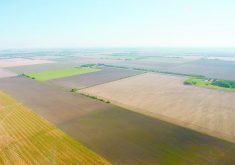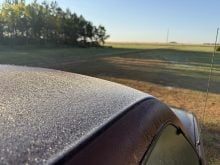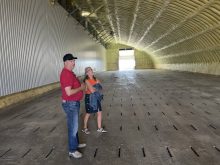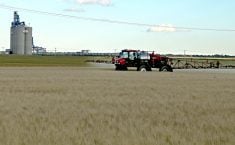Angry homeowners near East St. Paul, Man., want a company fined for composting lindane-treated canola seed in a nearby field.
Residents said they fought for months to get the toxic compost removed from the field near their homes.
One of their greatest concerns is that residual pesticide will leach into the soil, contaminating wells and underground water.
Although Manitoba Conservation last week said the material was removed as of March 10, residents wondered how hazardous waste was allowed to get there in the first place.
Read Also

Saskatchewan amends farm land ownership regulations
The Canada Pension Plan Investment Board can no longer own Saskatchewan farmland.
“I’m shocked that something like this could take place without any consultation with the community,” said Cathy Cox, whose three children played in the compost before it was fenced off and residents learned what it was.
“I’m really surprised that someone would jeopardize our health by dumping this stuff in the back.”
Amount dumped
Mid-Canada Waste Management began hauling the seed to the field in mid November. At least 100 tonnes of the material were eventually placed there.
The seed already had gone through a treatment process that was meant to remove much of the lindane, said Dave Ediger, a regional director for Manitoba Conservation.
Ediger said his department took samples of the material before it was hauled to East St. Paul, a rural municipality on the outskirts of Winnipeg.
Those tests indicated lindane levels in the seed were below the province’s hazardous waste guidelines.
However, samples were again taken after the seed was hauled to East St. Paul.
The first of those samples found levels of pesticide residue up to 10 times what is considered hazardous waste material.
In early January, the East St. Paul municipal council ordered the compost removed.
Reeve Phil Rebeck said the composting site was set up without consultation with the local council. The RM would never have approved the project, he said, because it did not fit with the municipality’s development plans.
Concerned residents also took their cause to Manitoba Conservation.
John Rossol, a local resident, said they were given the run-around by the department, which he believes acted too leniently.
“It’s appalling that the government is letting this happen with no fines,” Rossol said.
“What’s right is right and what’s wrong is wrong, and they’re there to enforce the law.”
Mid-Canada Waste Management did not reply to requests for an interview.
Residents confirmed March 9 that the compost was being trucked away.
According to Manitoba Conservation, it was hauled to a privately managed hazardous waste facility south of Morris, Man.
Meanwhile, Mid-Canada has been ordered by the province to have a plan in place by the end of March to show how it will monitor the site at East St. Paul for possible contamination.
Ediger said the province has a year to decide whether to fine the company. Mid-Canada’s compliance with the order will influence whether fines are imposed.
Not to worry
Despite the mild weather in early March, Ediger said the ground at the site remained frozen. The compost was built on an impermeable base, he said, and there has been little precipitation to cause runoff.
“The risk of exposure to residents around the site has been minimal.”
However, Rossol wonders who will be held accountable if the local water supply is contaminated. He said thousands of residents could be affected if that happens.
Lindane is best known in Western Canada as a seed treatment for canola. The product is being weaned from the canola industry due to concerns that its use could jeopardize exports of Canadian canola to the United States.
Lindane can build up in the soil and there are concerns that it may persist in humans and animals once it enters the food chain, said Ken Plews, manager of pesticides and fertilizer approval for Manitoba Conservation.
Plews described the product as highly toxic, but he could not confirm whether it is carcinogenic.
“It depends on who you talk to as to whether it is or isn’t,” he said in an interview last week.
















